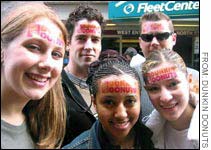NEW YORK (CNN/Money) - In the Age of TiVo, will everything be an ad?
Though the personal video recorder (PVR) pioneer TiVo has been much discussed, it's still a rarity in U.S. homes, with fewer than 1 million Americans owning one of the boxes. That's changing, as cable and satellite systems install PVR technology and TiVo itself expands.
A recent study by the Yankee Group forecasts that PVR use by Americans will rise from less than 4 percent today to more than 20 percent by 2007. That could cost TV networks $5.5 billion annually within four years, more than 10 percent of the $50 billion spent on commercials today.
 |
|
| Some coffee for those heads? |
For marketers, technological hurdles go hand in hand with another rising phenomenon: viewer burnout. "Audiences are so sophisticated these days," says TV producer Matti Leshem, CEO of Diplomatic Productions in Los Angeles. "Blatant, in-your-face advertising just doesn't work."
To break through to a jaded public, marketing is becoming more creative -- and perhaps more insidious. Commercial messages are popping up on TV shows purporting to be non-fiction, in songs not identified as jingles, even in casual conversations on street corners.
When Sony Ericsson rolled out its picture-taking T68i mobile phones last year, for example, the company launched a promotional campaign and hired 120 actors to explain photo phones.
The actors weren't on TV; they played their roles live. In various crowded places -- New York City bars, the Space Needle in Seattle Center -- the actors posed as tourists, going up to people and asking them to take pictures using the T68i.
They were never identified as Sony employees, just friendly folk with nifty new cameras.
"They were taking advantage of the kindness of strangers to get the product in the hands of unsuspecting consumers," says Gary Ruskin, executive director of Commercial Alert, a consumer watchdog in Portland, Ore.
Watch out for the treadheads
In July, strolling Bostonians encountered the "treadheads," six young men with hair shaved in the pattern of a tire tread. The sextet wandered the streets of the Hub wearing t-shirts that read, "What's up with my head?"
The answer: Goodyear was paying them $30 an hour to be walking billboards for its Dunlop Tires brand.
"Goodyear wanted to do something edgy," said Brett Zaccardi of Street Attack, the Boston-based guerilla marketing firm that ran the promotion. "We took an outlandish idea and put it into motion."
The treadhead campaign was clearly identified as marketing, however quirky. Still, the objective was the same as Sony's clandestine approach: to break through the clutter.
"It's getting harder to connect because of this immunity people feel to a barrage of ads," said Zaccardi. "People are tuning out."
Other marketers have used the human body as a canvas for advertising, too.
During the NCAA basketball tournament in March, Dunkin' Donuts hired college kids to tattoo the company's logo onto their heads. The attention the "headvertisers" got while watching games at ten locations around the country was worth far more than the estimated $50 to $100 a day the company paid them.
In April, Reebok pulled a similar stunt at the Boston Marathon, when 100 students were paid to wear temporary tattoos. The team then convinced about 1,000 other people to be emblazoned with Reebok marketing messages for free.
E.T. phone home
The Land of Make-Believe has long been home to the stealthy shill.
At least since 1982 -- when Steven Spielberg's "E.T." helped boost sales of Reese's Pieces by a reported 66 percent – Hollywood has embraced the notion that if brands are to be a part of their stories, producers might as well get paid for it.
These days, paid product placement is an elemental part of movie financing. Miramax Studios, for example, is said to be asking $35 million for the rights to be the Green Hornet's car of choice in an upcoming movie based on the old TV superhero.
TV producers and networks are cashing in, too.
When it's first and ten on CBS's broadcasts of college football games this season, an animated version of AOL's "Running Man" logo appears on the scrimmage line. The little guy is as much a part of the action as the referees moving chains.
 |
|
| But will they now shill Pepsi? |
The image is just an ad, of course, superimposed on the field. Corporate critic Ruskin says it's obnoxious nonetheless.
"Sports programming has a documentary function. It's supposed to be real, like a newscast," he said. "When you blur the line between what's happening at the stadium and what you see on TV, it's only a matter of time before you start to wonder about the game itself."
Other putatively "true" shows are more brazen. This past summer, "Survivor" creator Mark Burnett launched the reality TV series, "The Restaurant," which depicted the opening of a New York City eatery.
The show was unusual in that NBC, which aired it, paid no licensing fee. Instead, the producers took a larger-than-usual cut of the ad sales. The chief sponsor, American Express, bought traditional commercials, but also paid to weave its products into each episode.
Example: In one scene, star chef Rocco DiSpirito interrupts what he's doing, turns to the camera, and instructs his business manager to "call American Express. They have this Open for Business program that will take care of everything you need."
Art versus reality
"The next period in TV marketing is going to be all about finding effective ways to integrate brands into shows," says producer Leshem, whose credits include the game shows, "Who Wants to Be a Millionaire?" and the recent "Pepsi Play for a Billion."
Besides consumer ennui, PVR technology like TiVo is a driving force. From the perspective of advertisers, TiVo is subversive because it allows viewers to -- gasp -- skip past the commercials without viewing them. Hence, the smudging of the line between ads and acting.
Game shows and reality programming jumped on board first. Pepsi wove products directly into a number of series. Rival Coke dictated the set colors on "American Idol," and mandated that soda be drunk early and often.
Now, dramas are joining in. On the WB's "Gilmore Girls," stars Lauren Graham and Alexis Bledel are paid to eat Pop-Tarts. The Girls -- not the actresses as spokespeople, but the characters -- do commercial spots for Aquafina, too.
In other words, it's hard to tell when the show ends and the ad begins. Art imitating life?

|

